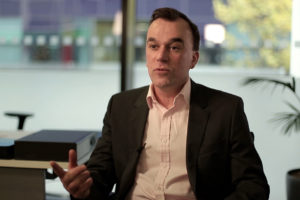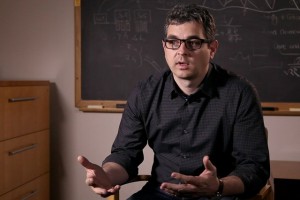Glaciology and Climate Change
Glaciologist Martin Siegert on the history of glacial theory, lake Vostok research and what ice tells us about...
I once wrote a book that’s called ‘The Language of the Genes’. It’s a fairly obvious parallel between language, the transmission of information through words, and the transmission of information through DNA. DNA is a kind of language: it is a series of instructions which tell cells of the body what to do. If you learn a language you can’t speak it unless you know and understand the grammar, so it’s all very well and good having words but unless you know the way these put together you can’t speak the language.
Evolution is the grammar of biology. Charles Darwin who came up with the theory of evolution in 1859 in ‘The Origin of Species’ actually more or less invented biology as a science. Before him there were plenty of people doing good biological research: for example, finding new fossils, discovering new kinds of plants and animals, looking at the migration of birds, breeding better plants and crops, breeding better farm animals… All these people were doing biology and they’re all doing the same thing. But they didn’t realize they were doing the same thing. Once ‘The Origin Species’ came out suddenly everything fell into place, so if I’m teaching biology, evolution now I could take examples from plants, from humans, from bacteria and just weave them together into a single narrative. That’s what evolution does.
It’s very strange to me that so many people across the world are determined to deny the fact of evolution: they somehow think that it drags them down to the level of the animals. In my view it does exactly the opposite: we do so many things which are unique to us that we set ourselves apart from the animal kingdom. But many people have a false idea about what evolution actually is. They see it as a kind of faith or doctrine but it’s not: it’s only science. You can summarize what evolution is in Darwin’s phrase: he called it ‘descent with modification’. Descent is the passage of information from one generation to the next, and modification is the fact that this passage is imperfect, that there are mistakes, errors, mutations as we call them now.
We can rephrase Darwin’s three words today: evolution is genetics plus time. If you’ve got genetics (DNA, genes) and you’ve got time (and we know that we have thousands of millions of years since the origin of life) and if you’ve got mistakes, mutations – and they happen all the time – then evolution is bound to happen. Nothing magical about it at all: it’s got to happen, it’s like taking a photocopy of a photocopy of a photocopy. Mistakes are made every time and so the image changes.
But then Darwin came up with the central part of that mechanism which is what he called natural selection. One of the standard complaints about evolution is that it can’t be true, how could a simple mechanism, a biological mechanism design or produce something like the human eye which is fantastically complicated? Many people say that you can’t have design without a designer, but natural selection does that, natural selection is a series of successful mistakes. There are mutations, errors, and some of those mutations actually increase the chance that those who inherit them will survive and will reproduce and pass on their genes.
So natural selection consists simply of inherited differences in reproductive success. It’s a two-part exam, you need to do two things: you have to stay alive (and of course most people now stay alive in the developed world until they’re old enough to reproduce) and then you have to find a mate and have children. There are differences among people, like among fruit flies and among dogs, in the ability to do that. That’s natural selection. Very quickly you can generate these amazingly complicated objects like the human eye, or the human knee, or the bacterial cell wall – by this simple mechanism.
So that’s what evolution is. The question is what kinds of evidence are there for evolution? Darwin wrote his book ‘On the Origin of Species’ in a great rush because he got a letter from the Far East, by Alfred Russel Wallace who independently had had the same idea. Darwin has been thinking about nutrition for 30 years and he never really put anything on the paper. He got this letter in 1857 which completely shattered him: he said ‘All my originality has been smashed’ and then immediately sat down and started writing ‘The Origin of Species’. He called it ‘a sketch’. This building here, the Darwin building, is on the site of Darwin’s house in London, so we feel really very close to Charles Darwin.
He called his book a sketch, and if you read it, which I have many times, you know it’s a hundred twenty-seven thousand words long. Not exactly a sketch. But he wrote it in less than a year with a pen, not with a word processor. In the beginning, he says that this book is one long argument, and it’s very-very clever in laying out the evidence for evolution. It starts off with something which is completely familiar: farming. The first chapter is called ‘Variation Under Domestication’. He points out that’s if you go to a farm you’ll find some cattle that produce beef and some cattle that produce milk; you’ll find some plant that produces seeds, some plants that produce big tubers. And yet they’re obviously related to wild animals like wild cattle or grasses for the plants which don’t do this at all. So why should this be? Well, obviously farmers in the past have been choosing, selecting the cows that produce most milk or weeds that produce most seeds, and if you do that long enough you will have changes, you’ll have evolution. That’s obvious, everyone can see that.
The next chapter is called ‘Variation Under Nature’: in other words, this could happen in the wild as well. Darwin talks about examples where that might happen. Of course, now in the modern world, there are hundreds of them, some of them are very familiar like the evolution of resistance to drugs, to antibiotics by bacteria. Bacteria have evolved by natural selection resistance to almost all known antibiotics, there is only one left now and that too would probably become useless in the next ten years. That’s Darwin’s mechanism happening in front of your eyes. Then he goes on through the various points; he has a lot about fossils (of course he knew very little about fossils but he has a lot about them), he has a lot about geography and islands in particular.
Famously Charles Darwin visited the Galapagos Islands in the Pacific. It didn’t form his ideas at all, he only spent there five weeks of his journey around the world on the Galapagos, and he collected the birds which are now called Darwin’s finches: he collected them but he didn’t take any notice of them, he just jumbled them all together. But one thing he did notice which really set the idea of change in his mind was that if you looked at the plants and the animals of the Galapagos Islands which are a couple of hundred kilometres out in the ocean from South America, volcanoes that come up from the bottom of the sea, they were remarkably similar to the animals and plants in South America. But before getting to the Galapagos Darwin had come south from Britain and had visited in the Atlantic the Cape Verde Islands. They too are volcanic islands out in the ocean about three or four hundred kilometres from the African coast. If you show a picture of the Cape Verde Islands and the Galapagos Islands, they look almost exactly the same.
But the Cape Verde Islands animals and plants were like those on Africa, not like those on the Galapagos. Of course, in those days before the evolution, many people believed in a god or something and creating plants and animals to fit the environments in which they live. Now, because the Cape Verde and the Galapagos are so similar, if it was a creator or some magical scheme, you would expect the plants and animals of these two islands to be the same, but they’re not. They’re similar to – but different from – the nearest mainland.
That gave Darwin the idea of change, and once you have the idea of change then suddenly you need to have a mechanism, and at the very end of his ‘The Origin of Species’, two pages from the end, he dares to say ‘Light will be cast upon man and his origins’. That’s what really scared people – the idea that humans had emerged from this apparently simple mechanism. Well, it may scare them but it’s true. It’s clearly true. The evidence of human evolution is now overwhelming and, in fact, obvious. Queen Victoria went to London Zoo in the 1830s before ‘The Origin of Species’ was published. She was a highly intelligent woman. She wrote in her diary that she visited the orangutan which was called Jenny, and she writes in her diary that the orangutan is ‘painfully and obviously human in appearance’. So she could see the obvious similarity between Apes and ourselves but she couldn’t believe that it was there because, of course, she believed in Creationism as did many people. But later in her life she actually used to read ‘The Origin of Species’ to her children in bed: I’m sure that set them to sleep straightaway.
So that’s the history of evolution. Now, of course, it’s in a new phase because now we’re in a situation where we can study the evolution and change of anything we like with modern technology. This has answered many-many problems: it’s shown absolutely directly that we are, of course, closely related to chimpanzees. The fossils and genes combined told us that our common ancestor with chimpanzees existed only about 7 million years which in terms of evolution is yesterday. It tells us that there’s much more variation than we ever thought. It tells us that there are large numbers of genes – not as many as we expected, there are only about 23,000 genes that go to make a human being. To put into context of human complexity (and we are complex creatures), there are about the same number of genes that make a human being as there are parts in a London transport double-decker bus. There are 23,000 parts in a double-decker bus and there are 23,000 genes that go to make humans.
But what that tells us is we don’t understand the way the genes are put together, so we have a lot more to learn. The evolution will tell us much more about it. Most important perhaps, evolution is beginning to tell us something about the origin of species: strangely, that is the one question which is not really approached in Darwin’s book. Darwin’s book is called ‘On the Origin of Species by the Preservation of Favoured Races in the Struggle for Life’, that’s its full title. But when you look at it there’s very little about the origin of species in it. The reason is that you can’t do genetics with different species, you can’t take cats and dogs and cross them together to see what comes out because nothing comes out. Species in some ways are like republics: each one is a republic of genes, sometimes with a bit of leakage between two adjacent species, but not very much. But with modern technology, we can look at the genes for species and we can see which ones are involved in making species distinct. So really, as always happens in science, new technology has answered lots of evolution questions but it’s posed an awful lot more.

Glaciologist Martin Siegert on the history of glacial theory, lake Vostok research and what ice tells us about...

MIT Assistant Prof. Thomas Heldt on new ways to monitor patient health, how patients and clinicians can benefi...

Scientists used 3D-printing technology to investigate the possible reasons why seahorse's tail evolved into it...